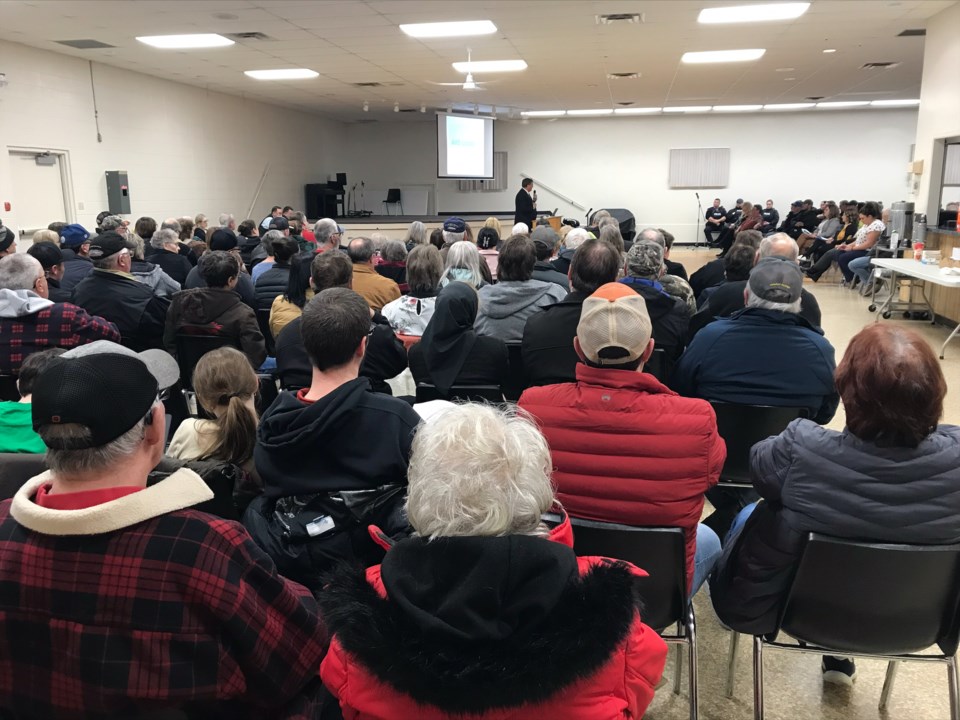ATHABASCA – Alberta Health Services (AHS) officials are insistent that the Boyle Healthcare Centre will not close and they’re working on solving the staffing crisis which has led to the facility operating on limited hours since the summer of 2022.
Close to 350 people packed the Boyle Community Centre Feb. 8 for close to two hours to listen to AHS’ detailed plans of the future of the facility, while Athabasca-Barrhead-Westlock MLA Glenn van Dijken discussed the process of attracting more staff to rural Alberta. Village of Boyle mayor Colin Derko, Town of Athabasca mayor Rob Balay and Athabasca County reeve Brian Hall, deputy reeve Ashtin Anderson and Div. 9 Camille Wallach also took turns at the mic, while the night ended with a question-and-answer session with the public.
“The biggest, most important message that I can deliver tonight, is that the hospital is not closing. We have a plan in place, to get beds and the ED open 24 hours a day,” said AHS area operations director Janet Barclay.
van Dijken talked about the obvious staffing struggles for the hospital, which has been on reduced hours since July 1, 2022 and said Boyle is not alone in its need for staff as it’s a problem across North America. When he talked about the previous staffing issues at the hospital, he said “ … we don’t have a shortage of doctors in the province of Alberta, we just have a distribution problem.” The anecdote spoke to a common theme throughout his speech that while parts of the system are broken they appear to be, “ … getting to a point of resolution, (with) some light at the end of the tunnel.”
Barclay provided some background into the issue and said the hospital is what AHS calls a ‘single registered nurse (RN) facility’, meaning at any point in time, there needs to be one RN on site, since the physicians are on call. Currently, the hospital is lacking three full-time nurses, or the part-time equivalent. The good news, Barclay said, was that they have two full-time nurses lined up from a program that helps with international recruitment, and that they should be here in the spring when they’ll receive around eight to 12 weeks of supported practice. This means that, on the current trajectory, the hospital should be fully re-opened by the middle of summer.
The other local leaders talked about the role that their respective municipalities had played in the process — be it recruitment, retention, or lobbying. Derko, Balay, and Hill, when asked about the success of the event and the process leading up to it, all highlighted the importance of working together.
“I think it makes all the difference. When you put yourself in the other persons shoes, I look at it like, if I was a minister or an MLA, and I’ve got three individuals coming that are interlocked as a community, and are working together, how can you not listen?” said Derko, in a follow-up interview. He also talked about how getting the hospital back open was the first step, and that now the focus will shift to increasing the numbers of other medical staff, including physicians and EMS, operating out of the region.
When asked about what steps AHS was going to take to prevent the reoccurrence of this problem down the road, Sherry Gough, the interim AHS senior operating officer for the rural east, said that “AHS is partnering with the municipality and the county to support new employees of the Boyle Healthcare Centre. When new staff and their families are welcomed into the community, they are more likely to continue working in the local facilities. AHS continues to recruit locally and internationally trained professionals to rural healthcare facilities, including Boyle.”
The Q&A
The questions from the audience, who appeared frustrated by the constant closures and seeming inaction to solve the crisis, ran the gamut with some even asking why masks still need to be worn at the hospital, while another wondered how many nurses had been let go because they hadn’t been vaccinated against COVID-19.
In the same follow-up interview, Derko said that he was proud “ … there were some stern, difficult questions asked, but it was respectful.”
One the best questions of the night came from an unidentified ex-nurse who worked at the facility and queried: “Has there had been any thought into improving our bed usage, whether that be some rooms turned into long term care rooms for people who are waiting to go into an actual long term care facility … this would bring up the numbers in the hospital, which might help attract people to stay?”
Barclay replied that they had been talking about what the right patient mix was for the hospital, noting the woman was right, it did need to be a mix of patients who were acutely ill, patients who were transitioning between facilities, and possibly some palliative care beds.



